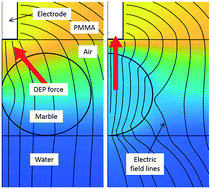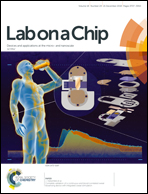Manipulation of a floating liquid marble using dielectrophoresis†
Abstract
A liquid marble is a microliter-sized droplet coated with hydrophobic powder. The porous coating prevents the liquid content from being in direct physical contact with its surroundings, making the liquid marble perfectly non-wetting. On the one hand, the non-wetting ability allows the liquid marble to float and move across a liquid surface with little resistance. On the other hand, the porosity enables gas exchange between the liquid marble and its surroundings. These properties allow the liquid marble to serve as a bioreactor platform for important applications such as cell culture. Liquid marbles floating on a free liquid surface prevent evaporation due to the high humidity near the liquid surface. Moving a floating liquid marble allows for stirring and mixing inside the liquid marble. This paper reports a novel technique for manipulating a floating liquid marble using dielectrophoresis. A relatively simple setup can move liquid marbles of various sizes across the water surface at high speeds. We also present an analytical model to model and accurately predict the motion of the floating liquid marble. The technique reported here potentially allows for high-throughput and efficient handling of floating liquid marbles as a digital microfluidics platform.



 Please wait while we load your content...
Please wait while we load your content...